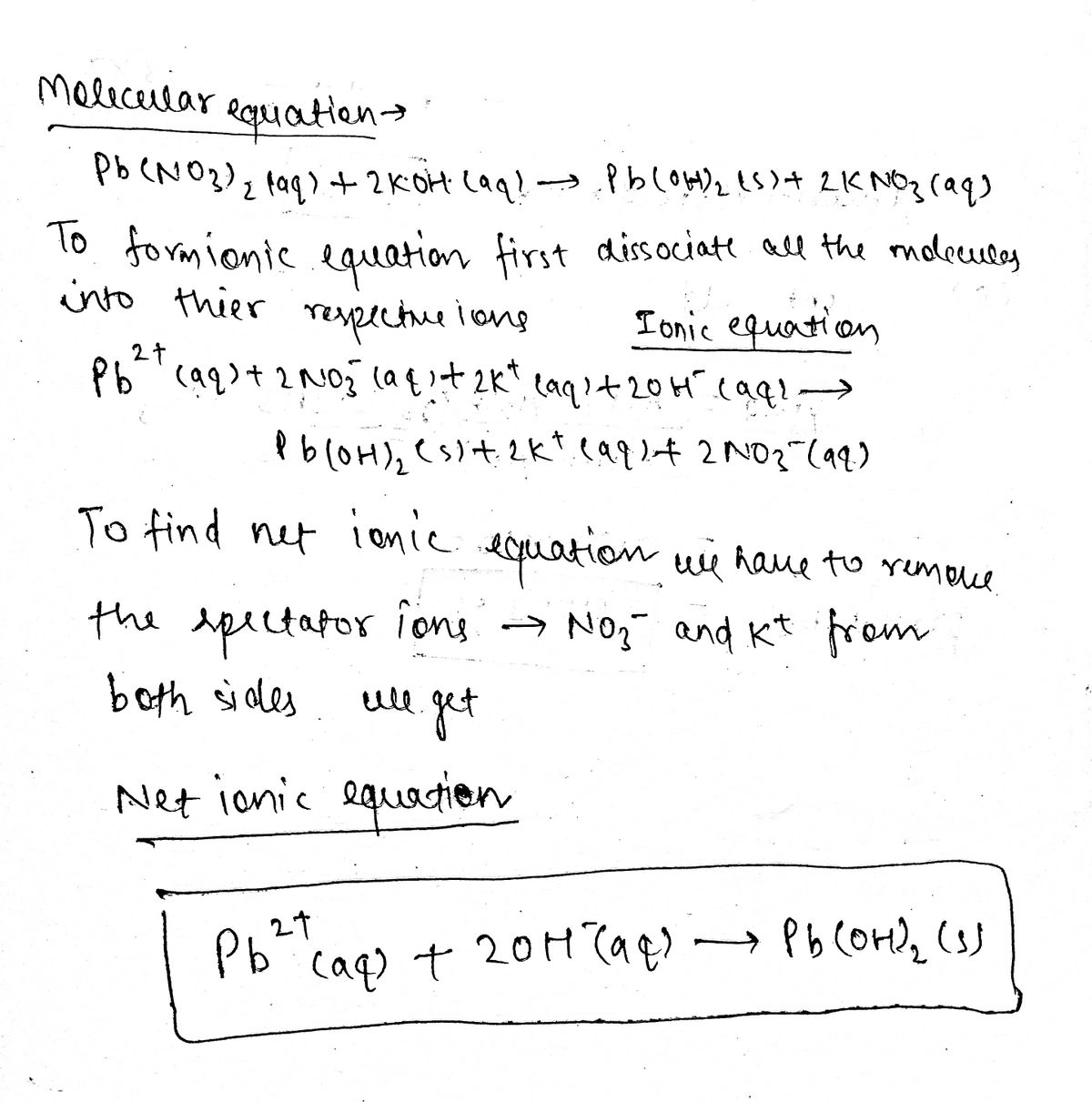**Title: Understanding Ionic and Net Ionic Equations** **Complete Ionic and Net Ionic Equations for the Following Reaction** This exercise involves writing the complete ionic and net ionic equations for the given chemical reaction: \[ \text{Pb(NO}_3\text{)}_2\text{(aq)} + 2\text{KOH(aq)} \rightarrow \text{Pb(OH)}_2\text{(s)} + 2\text{KNO}_3\text{(aq)} \] ### Explanation: 1. **Reactants:** - **Pb(NO₃)₂(aq):** Lead (II) nitrate is in aqueous form, meaning it disassociates into ions in water. - **2KOH(aq):** Potassium hydroxide is also in aqueous form, disassociating into potassium (K⁺) and hydroxide (OH⁻) ions. 2. **Products:** - **Pb(OH)₂(s):** Lead (II) hydroxide is a solid, indicating a precipitate formation, which is a key part of identifying the net ionic equation. - **2KNO₃(aq):** Potassium nitrate remains in aqueous solution, disassociating into potassium (K⁺) and nitrate (NO₃⁻) ions. ### Writing the Equations: - **Complete Ionic Equation:** Break all aqueous compounds into their respective ions: \[ \text{Pb}^{2+}\text{(aq)} + 2\text{NO}_3^{-}\text{(aq)} + 2\text{K}^+\text{(aq)} + 2\text{OH}^-\text{(aq)} \rightarrow \text{Pb(OH)}_2\text{(s)} + 2\text{K}^+\text{(aq)} + 2\text{NO}_3^{-}\text{(aq)} \] - **Net Ionic Equation:** Remove the spectator ions (ions that appear on both sides of the equation) - potassium (K⁺) and nitrate (NO₃⁻): \[ \text{Pb}^{2+}\text{(aq)} + 2\text{OH}^-\text{(aq)} \rightarrow \text{Pb(OH)}_2\text{(s)} \] In the net
**Title: Understanding Ionic and Net Ionic Equations** **Complete Ionic and Net Ionic Equations for the Following Reaction** This exercise involves writing the complete ionic and net ionic equations for the given chemical reaction: \[ \text{Pb(NO}_3\text{)}_2\text{(aq)} + 2\text{KOH(aq)} \rightarrow \text{Pb(OH)}_2\text{(s)} + 2\text{KNO}_3\text{(aq)} \] ### Explanation: 1. **Reactants:** - **Pb(NO₃)₂(aq):** Lead (II) nitrate is in aqueous form, meaning it disassociates into ions in water. - **2KOH(aq):** Potassium hydroxide is also in aqueous form, disassociating into potassium (K⁺) and hydroxide (OH⁻) ions. 2. **Products:** - **Pb(OH)₂(s):** Lead (II) hydroxide is a solid, indicating a precipitate formation, which is a key part of identifying the net ionic equation. - **2KNO₃(aq):** Potassium nitrate remains in aqueous solution, disassociating into potassium (K⁺) and nitrate (NO₃⁻) ions. ### Writing the Equations: - **Complete Ionic Equation:** Break all aqueous compounds into their respective ions: \[ \text{Pb}^{2+}\text{(aq)} + 2\text{NO}_3^{-}\text{(aq)} + 2\text{K}^+\text{(aq)} + 2\text{OH}^-\text{(aq)} \rightarrow \text{Pb(OH)}_2\text{(s)} + 2\text{K}^+\text{(aq)} + 2\text{NO}_3^{-}\text{(aq)} \] - **Net Ionic Equation:** Remove the spectator ions (ions that appear on both sides of the equation) - potassium (K⁺) and nitrate (NO₃⁻): \[ \text{Pb}^{2+}\text{(aq)} + 2\text{OH}^-\text{(aq)} \rightarrow \text{Pb(OH)}_2\text{(s)} \] In the net
Chemistry
10th Edition
ISBN:9781305957404
Author:Steven S. Zumdahl, Susan A. Zumdahl, Donald J. DeCoste
Publisher:Steven S. Zumdahl, Susan A. Zumdahl, Donald J. DeCoste
Chapter1: Chemical Foundations
Section: Chapter Questions
Problem 1RQ: Define and explain the differences between the following terms. a. law and theory b. theory and...
Related questions
Question
![**Title: Understanding Ionic and Net Ionic Equations**
**Complete Ionic and Net Ionic Equations for the Following Reaction**
This exercise involves writing the complete ionic and net ionic equations for the given chemical reaction:
\[ \text{Pb(NO}_3\text{)}_2\text{(aq)} + 2\text{KOH(aq)} \rightarrow \text{Pb(OH)}_2\text{(s)} + 2\text{KNO}_3\text{(aq)} \]
### Explanation:
1. **Reactants:**
- **Pb(NO₃)₂(aq):** Lead (II) nitrate is in aqueous form, meaning it disassociates into ions in water.
- **2KOH(aq):** Potassium hydroxide is also in aqueous form, disassociating into potassium (K⁺) and hydroxide (OH⁻) ions.
2. **Products:**
- **Pb(OH)₂(s):** Lead (II) hydroxide is a solid, indicating a precipitate formation, which is a key part of identifying the net ionic equation.
- **2KNO₃(aq):** Potassium nitrate remains in aqueous solution, disassociating into potassium (K⁺) and nitrate (NO₃⁻) ions.
### Writing the Equations:
- **Complete Ionic Equation:**
Break all aqueous compounds into their respective ions:
\[ \text{Pb}^{2+}\text{(aq)} + 2\text{NO}_3^{-}\text{(aq)} + 2\text{K}^+\text{(aq)} + 2\text{OH}^-\text{(aq)} \rightarrow \text{Pb(OH)}_2\text{(s)} + 2\text{K}^+\text{(aq)} + 2\text{NO}_3^{-}\text{(aq)} \]
- **Net Ionic Equation:**
Remove the spectator ions (ions that appear on both sides of the equation) - potassium (K⁺) and nitrate (NO₃⁻):
\[ \text{Pb}^{2+}\text{(aq)} + 2\text{OH}^-\text{(aq)} \rightarrow \text{Pb(OH)}_2\text{(s)} \]
In the net](/v2/_next/image?url=https%3A%2F%2Fcontent.bartleby.com%2Fqna-images%2Fquestion%2F377a7caf-b074-415b-a7a2-489899521086%2F06589245-11da-420a-87a9-31cc0d3ca683%2F8xk02so.jpeg&w=3840&q=75)
Transcribed Image Text:**Title: Understanding Ionic and Net Ionic Equations**
**Complete Ionic and Net Ionic Equations for the Following Reaction**
This exercise involves writing the complete ionic and net ionic equations for the given chemical reaction:
\[ \text{Pb(NO}_3\text{)}_2\text{(aq)} + 2\text{KOH(aq)} \rightarrow \text{Pb(OH)}_2\text{(s)} + 2\text{KNO}_3\text{(aq)} \]
### Explanation:
1. **Reactants:**
- **Pb(NO₃)₂(aq):** Lead (II) nitrate is in aqueous form, meaning it disassociates into ions in water.
- **2KOH(aq):** Potassium hydroxide is also in aqueous form, disassociating into potassium (K⁺) and hydroxide (OH⁻) ions.
2. **Products:**
- **Pb(OH)₂(s):** Lead (II) hydroxide is a solid, indicating a precipitate formation, which is a key part of identifying the net ionic equation.
- **2KNO₃(aq):** Potassium nitrate remains in aqueous solution, disassociating into potassium (K⁺) and nitrate (NO₃⁻) ions.
### Writing the Equations:
- **Complete Ionic Equation:**
Break all aqueous compounds into their respective ions:
\[ \text{Pb}^{2+}\text{(aq)} + 2\text{NO}_3^{-}\text{(aq)} + 2\text{K}^+\text{(aq)} + 2\text{OH}^-\text{(aq)} \rightarrow \text{Pb(OH)}_2\text{(s)} + 2\text{K}^+\text{(aq)} + 2\text{NO}_3^{-}\text{(aq)} \]
- **Net Ionic Equation:**
Remove the spectator ions (ions that appear on both sides of the equation) - potassium (K⁺) and nitrate (NO₃⁻):
\[ \text{Pb}^{2+}\text{(aq)} + 2\text{OH}^-\text{(aq)} \rightarrow \text{Pb(OH)}_2\text{(s)} \]
In the net
Expert Solution
Explanation

Step by step
Solved in 2 steps with 1 images

Knowledge Booster
Learn more about
Need a deep-dive on the concept behind this application? Look no further. Learn more about this topic, chemistry and related others by exploring similar questions and additional content below.Recommended textbooks for you

Chemistry
Chemistry
ISBN:
9781305957404
Author:
Steven S. Zumdahl, Susan A. Zumdahl, Donald J. DeCoste
Publisher:
Cengage Learning

Chemistry
Chemistry
ISBN:
9781259911156
Author:
Raymond Chang Dr., Jason Overby Professor
Publisher:
McGraw-Hill Education

Principles of Instrumental Analysis
Chemistry
ISBN:
9781305577213
Author:
Douglas A. Skoog, F. James Holler, Stanley R. Crouch
Publisher:
Cengage Learning

Chemistry
Chemistry
ISBN:
9781305957404
Author:
Steven S. Zumdahl, Susan A. Zumdahl, Donald J. DeCoste
Publisher:
Cengage Learning

Chemistry
Chemistry
ISBN:
9781259911156
Author:
Raymond Chang Dr., Jason Overby Professor
Publisher:
McGraw-Hill Education

Principles of Instrumental Analysis
Chemistry
ISBN:
9781305577213
Author:
Douglas A. Skoog, F. James Holler, Stanley R. Crouch
Publisher:
Cengage Learning

Organic Chemistry
Chemistry
ISBN:
9780078021558
Author:
Janice Gorzynski Smith Dr.
Publisher:
McGraw-Hill Education

Chemistry: Principles and Reactions
Chemistry
ISBN:
9781305079373
Author:
William L. Masterton, Cecile N. Hurley
Publisher:
Cengage Learning

Elementary Principles of Chemical Processes, Bind…
Chemistry
ISBN:
9781118431221
Author:
Richard M. Felder, Ronald W. Rousseau, Lisa G. Bullard
Publisher:
WILEY